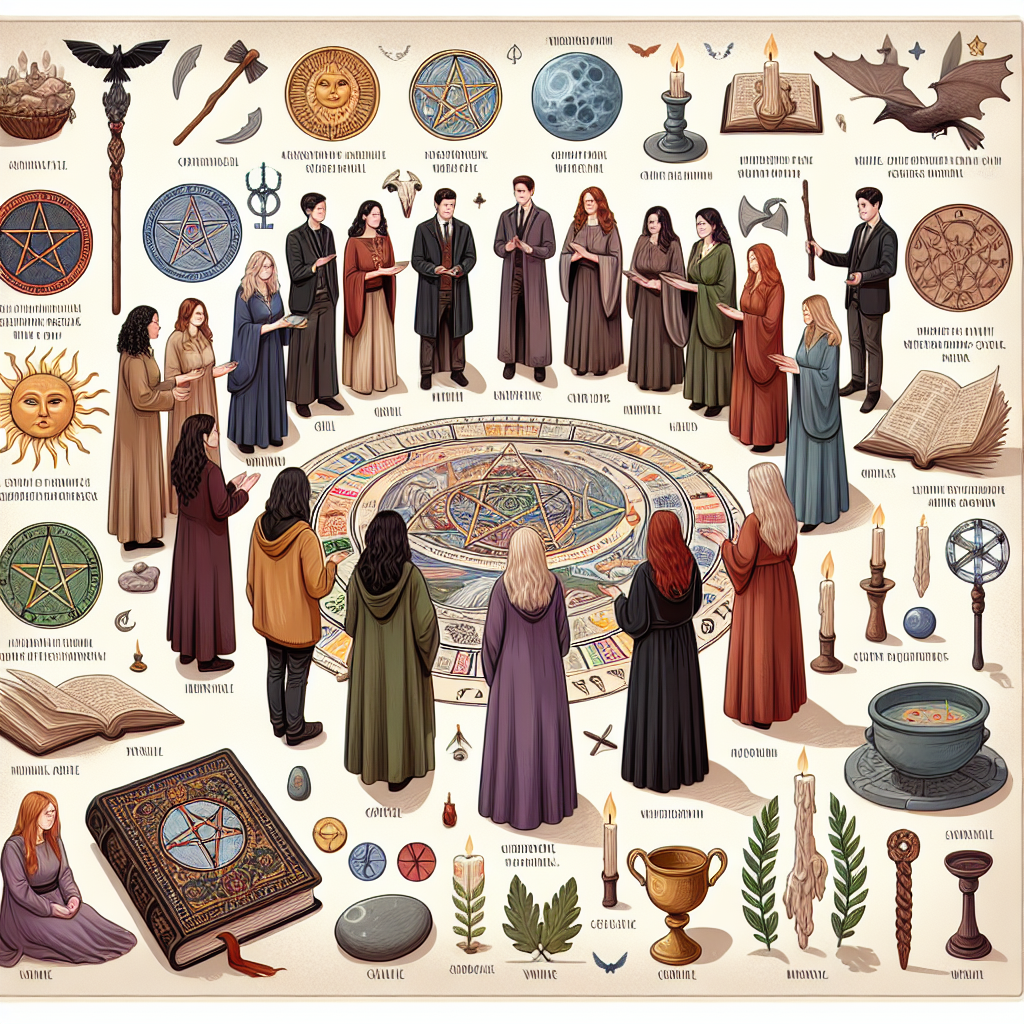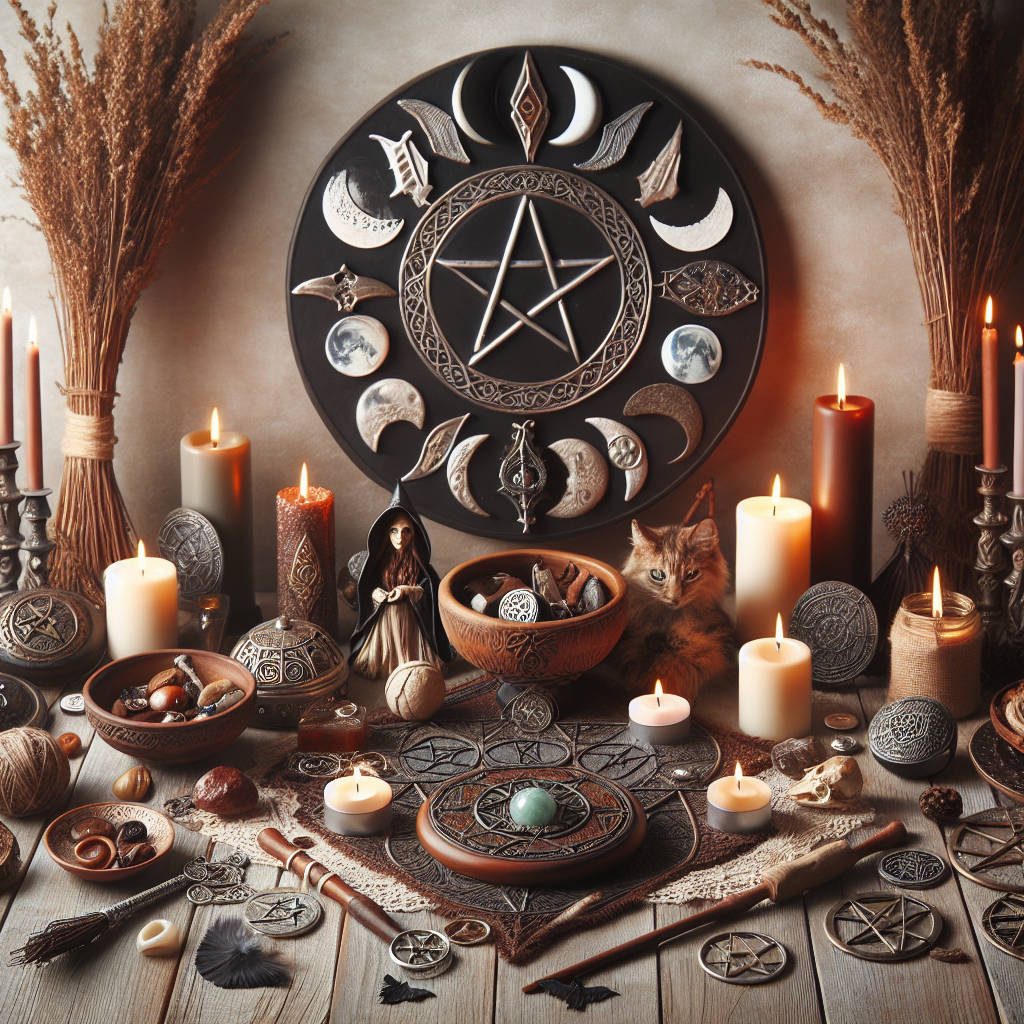As an Amazon Associate I earn from qualifying purchases.
In the world of Wicca, a coven typically refers to a gathering or community of witches who meet regularly to perform rituals and spells, and celebrate their faith together. Although Wiccan covens are commonly thought to adhere to a strict membership of thirteen individuals, this number can actually vary widely with some covens choosing a smaller cohort while others expand far beyond this traditional figure.
The concept of the coven has ancient roots, with its origins often linked to European witchcraft traditions. Covens became particularly integral to the Wiccan religion following its formalization in the early 20th century. Spearheaded by figures such as Gerald Gardner and Doreen Valiente, modern Wicca synthesized older pagan practices with more contemporary ceremonial magic, leading to the structured coven practices we recognize today.
One intriguing aspect of Wiccan covens is that they typically operate under a veil of secrecy. Originally, this secrecy served to protect its members from religious persecution. Nowadays, privacy continues to be an important aspect of coven life, allowing practitioners to create a trusted environment where they can express their beliefs openly.
Wiccan covens are often led by a High Priestess or a High Priest, or sometimes both, who are viewed not as rulers but as first among equals. Leadership within the coven is not about power over others; instead, it is about service to the coven’s members and to the deities they honor.
It is commonly believed that Wiccan covens exclude solitary practitioners, but many covens are actually quite welcoming of individuals who usually practice alone. Offerings of workshops, open rituals, and other events create bridges between solitary witches and coven members, fostering a larger sense of community and shared learning.
A fascinating statistical note is that the growth of Wicca and other Neopagan religions has been substantial over the past few decades. According to the Pew Research Center, in the United States alone, 0.4% of the population identified as Wiccan or Pagan in 2014, a significant increase from previous years. The actual numbers could be higher given that some practitioners choose not to reveal their spiritual path for various personal reasons.
Another lesser-known fact is that not all covens follow the same tradition or pantheon of deities. Wicca is a highly diverse religion, with different “denominations,” known as traditions, such as Gardnerian, Alexandrian, and Dianic, each with its own specific rites, practices, and deity forms. This diversity means that the experience of one coven can be vastly different from another, with some focusing more on Goddess worship, and others embracing a balance between masculine and feminine divine aspects.
“`html
What Are the Top 7 Intriguing Facts About Wiccan Covens You Likely Didn’t Know?
“`
A Wiccan coven is a gathering or community of practitioners of Wicca, a modern pagan, witchcraft religion. Often bonded by shared beliefs, rituals, and ethical codes, covens typically consist of a close-knit group of members who meet regularly to perform magick, celebrate sabbats, and support each other’s spiritual growth. Immersed in mystery and surrounded by nature-centric practices, covens play a vital role in the Wiccan faith, functioning as spaces for learning and preserving the craft’s secrets, lore, and traditions. From their secretive initiation rites to the unique energy harnessed within the circle, Wiccan covens harbor numerous fascinating aspects that are seldom known to the outside world. To explore these engaging tidbits further, join us as we delve into the esoteric world of Wiccan covens, unveiling the traditions and practices that define this enchanting facet of the Wiccan spiritual path.
A Wiccan coven is a gathering of practitioners of Wicca, a modern pagan religion that incorporates witchcraft. Covens are often the primary communal structure within this belief system, providing a framework for rituals, teaching, and community support. Delving into Wiccan Coven Facts reveals a rich tapestry of practices and traditions that many may not be familiar with. Here are seven fantastic little-known facts about Wiccan covens:
1. **Traditional Size and Structure:** The traditional number of members in a Wiccan coven is thirteen, a number deemed significant within Wiccan symbolism. However, this is not a strict rule, as covens can vary widely in size. A coven is typically led by a High Priestess and, in some cases, a High Priest. They are responsible for guiding rituals, training members, and often acting as a liaison with the wider Wiccan community.
2. **Degrees of Initiation:** Within many Wiccan covens, there exists a system of degrees that signifies a member’s level of knowledge and experience. These are often three-fold, with each level bringing a deeper understanding of Wiccan lore and greater responsibilities within the coven. Advancement requires intensive study, mentorship, and the performance of various rites.
3. **Autonomy of Covens:** Wiccan covens are autonomous and can differ greatly in how they approach worship and the craft. While they may share core beliefs and observances of Wiccan holidays (Sabbats) and moon phases (Esbats), covens can have their own unique rituals, traditions, and interpretations of Wiccan tenets, sometimes even creating their own Book of Shadows—the coven’s collection of Wiccan knowledge and rituals.
4. **Secrecy and Privacy:** Many covens operate in secrecy or with a high degree of privacy. This stems from historical persecution and modern misconceptions about witchcraft and paganism. Privacy allows members to practice their faith freely without fear of discrimination. Consequently, finding a coven can sometimes be a challenge, requiring seekers to network and gain trust within the Wiccan community.
5. **Contributions to Eco-Spirituality:** Wiccan covens are often deeply engaged with nature and ecological conservation. Rituals are conducted to honor the seasons, and many covens are actively involved in ecological actions and promoting sustainability, seeing the Earth as a living entity and stewardship as a sacred duty.
6. **Egalitarian Practice:** Despite the presence of a High Priestess or High Priest, many covens operate using consensus-based decision-making. Covens often emphasize the equality of all participants, promoting a structure devoid of traditional hierarchical models. Each member is encouraged to contribute to the coven’s activities and well-being.
7. **Coven Births and Hiving Off:** When a coven becomes too large to function effectively, or when a member is ready to lead their own group, it’s common for a new coven to hive off from the original. This important practice allows for the spread of Wiccan traditions and maintains the intimate, familial atmosphere that many covens cherish. It’s akin to a parent coven giving birth to a daughter coven, fostering continued growth and diversification within the Wiccan community.
To quantify the reach and prevalence of Wiccan covens, a statistic worth noting is that Wicca as a religion has seen significant growth over the years. Recent surveys, such as the Pew Research Center’s studies on religion and public life, highlight Wicca’s rise, with estimates showing that the number of Americans identifying as Wiccan or pagan ranging into the hundreds of thousands. While not all practitioners join covens, the increase in self-identified Wiccans suggests a corresponding rise in coven activity and formation.
“`html
1. What exactly is a Wiccan Coven?
A Wiccan Coven is a gathering or group of practitioners of Wicca, who come together to perform rituals, celebrate sabbats, esbats, and share knowledge. Typically, a coven consists of initiated members who work together in a structured way under a shared tradition or set of practices.
2. How many members are typically in a Wiccan Coven?
Traditionally, a Wiccan coven is made up of 13 members, aligning with lunar cycles and the number’s significance in witchcraft. However, the number can vary, with some covens having fewer or more members depending on their specific traditions and logistical considerations.
3. Is it necessary to join a coven to practice Wicca?
No, it is not necessary to join a coven to practice Wicca. Many Wiccans are solitary practitioners who perform rituals and celebrate festivals on their own. Covens provide a community for shared rituals and learning, but individuals can also practice privately.
4. How do you become a member of a Wiccan Coven?
To become a member of a Wiccan Coven, one usually must undergo a process that may include meeting with coven members, expressing genuine interest, and possibly completing a period of study. Initiation rituals are commonly performed to welcome a new member into the coven.
5. Can anyone start their own Wiccan Coven?
Yes, someone with enough knowledge of Wiccan practices and rituals can start their own coven. It is often recommended that this person be an experienced and initiated Wiccan, though there are no strict rules preventing anyone from forming a group if they feel called to do so.
6. Are Wiccan Covens open to people of all backgrounds?
Most Wiccan Covens are inclusive and open to individuals of various backgrounds, as long as they share a genuine interest in Wicca and adhere to the ethical guidelines and practices of the coven. However, some covens may have specific requirements or traditions that guide membership.
7. What is the role of a High Priestess or High Priest in a Wiccan Coven?
The High Priestess or High Priest in a Wiccan Coven is often the leader who facilitates rituals, provides guidance, and acts as a representative of the Divine within the group. They are typically experienced practitioners who have undergone extensive training in Wiccan practices.
8. Do Wiccan Covens have a hierarchy or structure?
Many Wiccan Covens operate with a hierarchical structure, often with a High Priestess or High Priest at the top, followed by initiated members of different levels or degrees. However, some covens practice with a more egalitarian or consensus-based structure.
9. Are there different types of Wiccan Covens?
Yes, there are different types of Wiccan Covens that follow various traditions or paths within Wicca. Some well-known traditions include Gardnerian, Alexandrian, and Dianic Wicca, each with its own specific rituals and beliefs.
10. Can a Wiccan be a member of more than one coven at a time?
Typically, Wiccans are members of only one coven at a time as a sign of commitment and to maintain the integrity of rituals and teachings. However, practices can vary, and some Wiccans may be involved with more than one group if agreed upon by all parties.
“`

Conclusion
Exploring the realm of Wiccan covens has led us to uncover numerous fascinating aspects about this spiritual path. One of the lesser-known facts is that Wiccan covens are traditionally limited to thirteen members, a number symbolizing completeness and considered sacred within the practice. Initiations within a coven are often surrounded by elaborate rituals and can signify a deep commitment to the group’s shared belief system. These gatherings are not merely social clubs; they are hubs of earnest spiritual practice, where members commune with nature, deities, and the elements, engaging in spellwork, ceremonies, and teaching.
The intricate bond between coven members is based on mutual respect and confidentiality, establishing a secure space for spiritual growth. The leadership within a coven, often a High Priestess or High Priest, serves more as a guide than a strict ruler, fostering an environment of equality and collaboration. Despite the common stereotypes portrayed in popular culture, Wiccan covens are grounded in principles of harmlessness, following the Wiccan Rede’s tenet of “An it harm none, do what ye will.” Through the celebration of esbats and sabbats, covens honor the cycle of the moon and the wheel of the year, cultivating a connection with the rhythms of the universe. These gatherings serve not just as moments of worship but also as opportunities for practitioners to deepen their understanding and mastery of the Craft.
Amazon and the Amazon logo are trademarks of Amazon.com, Inc, or its affiliates.


